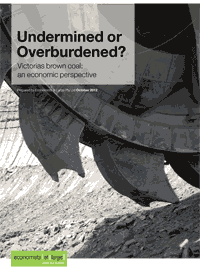The Victorian Government has announced its intentions to undertake an allocation of brown coal from the Latrobe Valley in 2012-13. The Valley’s coal is abundant and cheap to mine, with probable reserves of 65 billion tonnes. Currently 13 billion tonnes of ‘economic’ coal in the Latrobe Valley is unallocated, while 20 billion tonnes has been allocated to power stations and projects proposed in 2002 that received coal allocations but have not proceeded from Australia.
Environment Victoria has commissioned Economists at Large to undertake a study of the economics of Victoria’s brown coal resource and its potential uses, with an emphasis on the prospects of establishing an export brown coal industry. This is the stated aim of a number of the companies seeking a coal allocation from the State Government and of the State Government itself.
During a mining boom where coal exporting states and companies have enjoyed increased revenues and profits, it is not surprising that Victoria’s government and developers would want to explore opportunities to develop the coal resource.
However, this study concludes that there is no compelling economic case for a further coal allocation given the amount of allocated coal already in the market and the limited commercial interest in developing the resource. Furthermore there are substantial external costs associated with developing the coal resource, including impacts on local environments, health and the global climate that may outweigh the financial benefits of developing the resource.
Development of viable new domestic or export coal markets is unlikely for three key reasons:
1. Low quality resource:Victoria’s brown coal is of extremely high moisture content and low energy value and is volatile when dry. This makes it expensive to transport and impractical for use other than close to the mine itself.
The main use of Latrobe Valley coal is domestic electricity generation. Existing generators have ample supply and some are likely to close due to age and high carbon emissions intensity. Domestic uses of brown coal for new projects are likely to incur a significant carbon liability. No export market currently exists for coal of this grade. For Victorian coal to be marketable it needs to be processed.
2. Processing costs: Brown coal export projects will struggle against competition from higher rank thermal coal and other fuels. Costs associated with processing mean products derived from Victorian brown coal face a cost that competitors do not. As a result, these products are likely to be more expensive than those of competitors with higher quality coal resources. While processing costs of proposed coal-drying and coal-to-liquids technologies are unclear, they are unlikely to be viable.
3. Transport costs: Transport is an important factor in costs for any bulk commodity export. The Latrobe Valley is further from Pacific Basin buyers than all other suppliers such as Indonesia, Queensland, New South Wales, Mongolia, Russia and even South Africa. These additional shipping costs are very significant for current proposals . For instance if Exergen’s proposal to export 12 million tonnes of treated brown coal per year materialised it would face annual shipping costs of $50 million more than its competitors exporting low-grade coal from Indonesia to India. Furthermore, the ports from which projects propose to export generally do not yet exist.
While proposed projects seem unviable, there remains commercial interest inLatrobeValleycoal. This would appear to be due to the considerable subsidies that exist for technology development and the option value in large coal allocations. Proponents can receive support for research here that could be later exported to more cost-effective producers. Obtaining a coal allocation gives a developer an option value – the right, but not obligation, to use the resource in the future. Such options can be sold to other developers, as occurred after the 2002 coal allocation.
This report also concludes that even if proposed mining and coal treatment projects are viable, the claimed benefits of jobs and revenue are overstated. Jobs in mining projects generally do little to help local unemployment levels and often have negative effects on other industries such as manufacturing and agriculture. The report assesses some of the claims made by proponents of mining projects seeking a coal allocation and finds that many of the claims of economic benefit are implausible.
Victorianeeds to accept that it is unlikely to ever export large quantities of coal-derived products. Any attempt to develop a major export industry is a gamble that commodity prices are going through a historic shift that other suppliers will not respond to. As Adam Smith noted over two hundred years ago:
The value of a coal-mine to the proprietor frequently depends as much upon its situation as upon its fertility. (Smith, 1776)


I endorse these findings.
Expectations that Latrobe Valley brown coal will ever be exported for thermal power generation purposes are fanciful in this era of anthropogenic global warming. Even superior quality Bowen Basin sub-bituminous thermal coals such as Blair Athol and Clairmont measures have no comparative advantage on a landed CIF basis over other internationally traded thermal coals or indeed Indian, Chinese, Indonesian, South African and Russian thermal coals.
Hedonic modelling studies* suggest most Hunter Valley coals are purchased by Japanese utilities for security of supply and Japanese trading company equity considerations.
* Asia Pacific Strategy presentation to the Economic Society of Australia (Qld.) Inc, dated 28 July 2005.